


Experiments with magnets and our surroundings
Magnets in Motion
This page shows how the magnetic fields twist and bend as magnets are moved about with respect to each other.
After you wait for the computer to load the animated gif file, you may want to save it to your hard drive so you can watch it anytime without having to load it again. Do this by clicking on File, Save As or Save Page As, and then select Web Page Complete, and find a directory of your choice to save it in.
Two magnets, magnetized through its length. Starts with North on right hand side.
a. Starts as one magnet that is broken perpendicular to the line
connecting N and S poles (like a long bar magnet cut in half). The two
pieces are pulled apart, and reconnected, N to S. N is on the right hand
side. motion01.htm

This file is about 315K and will only take about 60 seconds to load (at
5.3KB/sec). Please be patient.
b. Two magnets pushed together with their N poles facing each
other. The magnet on the left hand side has its N pole on the right.
The magnet on the right hand side has its N pole on the left. motion02.htm

This file is about 334K and will only take about 63 seconds to load.
Please be patient.
c. Two magnets separated from each other, one rotating, the other
stationary. motion03.htm
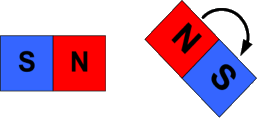
This file is about 356K and will only take about 67 seconds to load.
Please be patient.
d. A combination of all of the above. motion04.htm
This file is about 1055K and will only take about 3.5 minutes to load.
Please be extra patient - but it is well worth it! VERY COOL!
Two magnets, magnetized through its width. Starts with North on top.
a. Starts as one magnet that is broken parallel to the line connecting
N and S poles (like a disk magnet cut in half along its diameter). The two
pieces are pulled apart, and reconnected. N is on the top side for both
magnets. motion05.htm
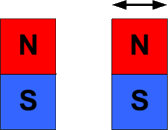
This file is about 348K and will only take about 66 seconds to load (at
5.3KB/sec). Please be patient.
b. Two magnets pushed together. The magnet on the left hand side
has its N pole on the top. The magnet on the right hand side has its N
pole on the bottom. motion06.htm
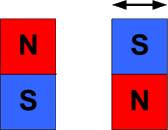
This file is about 339K and will only take about 64 seconds to load.
Please be patient.
c. Two magnets separated from each other, one rotating, the other
stationary. motion07.htm
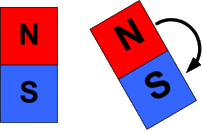
This file is about 356K and will only take about 67 seconds to load.
Please be patient.
d. A combination of all of the above. motion08.htm
This file is about 1050K and will only take about 3.5 minutes to load.
Please be extra patient - but it is well worth it! VERY COOL!
Five magnets, magnetized through its length. North is on the right hand side.
a. Starts as one magnet that breaks apart into five pieces. The
North pole stays on the right. You can see how the field lines connect the
pieces, even as the distance between them varies. motion09.htm
This file is about 693K and will only take about 2.2 minutes to load.
Please be patient.
Single magnet, North is on the right hand side, and a steel plate is used to shield the bottom half of the screen.
a. The magnet does not move, but the steel plate moves up toward the magnet. You can see how the field tends to prefer to flow through the steel, keeping the space below the steel plate relatively free of magnetic fields.motion10.htm
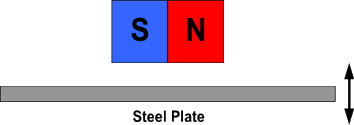
This file is about 390K and will only take about 73 seconds to load.
Please be patient.
Single magnet, North is on the top, and a steel plate is used to shield the bottom half of the screen.
a. The magnet does not move, but the steel plate moves up toward the magnet. You can see how the field tends to prefer to flow through the steel, keeping the space below the steel plate relatively free of magnetic fields. motion11.htm
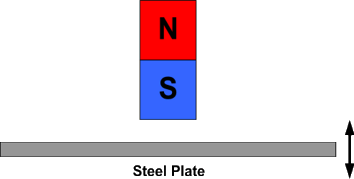
This file is about 455K and will only take about 86 seconds to load.
Please be patient.
Ring of magnets, making a monopole.
a. Building a ring of wedge shaped magnets, all of them with their North poles facing outward. Starts with space between each of them, and proceeds by bringing them closer and closer together until they all touch. The ring then splits apart and then everything goes in reverse. motion12.htm
Ring of magnets, portion of monopole animation.
a. Building a ring of wedge shaped magnets, all of them with their North poles facing outward. Starts with space between each of them, and proceeds by bringing them closer and closer together until they all touch. Then everything goes in reverse. motion13.htm
NOTES:
The files you download are animated gif files. These types of files are usually used on web pages to show some kind of movement or animation like envelopes flying through the air, smiling faces blinking at you, etc. Here is how they were created.
1. Using the Maxwell Student
Version software (send me an email if you want a copy), I created
a project by defining two magnets, specifying their sizes, material and the
orientation of their magnetization.
2. Ran the program to solve the project.
3. Plotted the flux lines using the Post Process function.
4. Created a bmp file showing the flux lines using the program's
"Grab Screen" utility under the Printing function.
5. Modified the project by moving one of the magnets a small amount and
solved the project again.
6. Created another bmp file showing the flux lines.
7. Repeated steps 5 and 6 in order to make a series of images where the
image is changed slightly each time. This is kind of like clay-mation or
stop-action movie making.
8. Converted all of the bmp files to gif files using Microsoft
Image Composer that came with Microsoft
Front Page. Don't forget to define white as a transparent color.
9. Used Microsoft
GIF Animator that came with Microsoft Image Composer in order to place each
gif file in the correct sequence for the movie. The bigger movies required
46 individual gif files, some were used more than once, to end up with a 76
frame movie.
10. Saved the sequence of gif files as a single, animated gif file.
This file is then called by the htm file that is displayed by your browser.
Fun stuff!!!